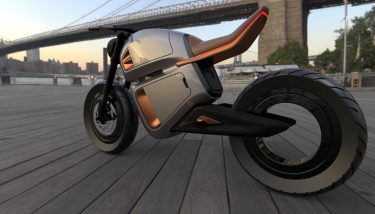“
NAWA Technologies, a French company that specialises in next-gen batteries, has revealed a world first zero emission motorbike concept that utilises ultracapacitors.
Called the NAWA Racer, it is the first electric motorbike to use ultracapacitors, integrating these with a lithium ion battery. This brings huge benefits in energy recovery, range, charging time and weight. The system is fully scale-able so it can be applied to cars too.

The electric motorbike will appear at the Consumer Electronics Show (CES) in Las Vegas on 7th January 2020.
According to the company, the NAWA Racer offers ten times more power and five times more energy than existing technology that features conventional lithium-ion cells.
The motorcycle makes the first time an electric motorbike has used ultracapacitors, the hybrid system offers the best of both worlds: ultra-fast charging, incredible energy recovery and high power output thanks to the ultracapacitors, and a long continuous range thanks to better lithium-ion management.
Inspired by the original café racers of London in the 1960s, which were lightweight, powerful bikes used for short, quick rides between cafés, NAWA Racer builds on these themes, boasting a raft of efficiency benefits that make it perfect for the city, with features other e-motorbikes cannot offer.
Next-gen ultracapacitors: the key to unlocking a hybrid battery
The basis of NAWA Racer’s advantage is the company’s carbon-based ultracapacitors, which charge and discharge in seconds, capable of picking up energy from regenerative braking and supplying it back to an electric motor very quickly. They can do this millions of times over without degradation, offering very fast energy transfer, unlike lithium-ion. But although they have five times more energy storage than existing technology, lithium-ion does still offer greater overall capacity.
By integrating these ultracapacitors into a lithium-ion system, the result is a battery that has much more efficient overall performance, greatly reducing the charge and discharge cycles the lithiumion battery performs, extending the life of the entire system. Regardless of electric vehicle, from motorbike to car, the efficiency improvements made by a hybrid ultracapacitor battery system can reduce the size of the lithium-ion battery by up to half, or extend the range by up to double – or a combination in between depending on use. This is especially the case where there is a lot of braking and accelerating, such as in an urban area.
Energy efficient and lightweight
Located in the bike’s top tank area is an arrangement of NAWA Technologies’ own ultracapacitors, known as NAWACap and offering 0.1 kWh, which boost a lithium-ion battery mounted low in the chassis where the internal combustion engine would otherwise be.

Re-using more than 80 percent of the energy captured from regenerative braking – lithium-ion can only re-use 30 percent – NAWACap brings major leaps in efficiency, allowing NAWA Racer to use a much smaller lithium-ion battery than would otherwise be possible: just 9 kWh, around half the size of a conventional electric sports bike’s battery.
The NAWACap pack itself is lightweight too, weighing as little as 10 kg, and combined with the bike’s carbonfibre frame and composite body panels, NAWA Racer tips the scales at just 150kg, a weight saving of 25 percent over conventional electric sports bikes. This lightweight, compact hybrid battery system results in exceptional range.
Thanks to its lithiumion battery, NAWA Racer can cover 150km on a mixed cycle, including highways. But the city is where it really shines. By capturing so much energy from stop-start riding, releasing it again as acceleration, NAWA Racer can double its range in an urban area, covering 300km between charges. The NAWACap pack recharges in just two minutes and the entire battery can be charged to 80 percent in one hour from a home supply.
Exhilarating performance – at all times
As standard, the hub-less rim motor produces 100PS, rocketing NAWA Racer from rest to 100km/h in comfortably under three seconds, onto a top speed in excess of 160km/h. And no matter the charge level of the lithium-ion battery, this acceleration will always be available because of the ultracapacitor’s high power characteristics, which continually maintain response and performance.
